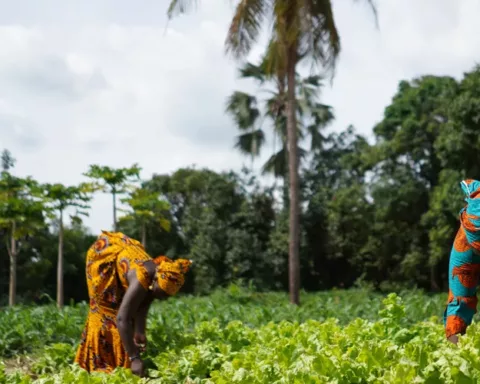The disease is expected to result in a deep global economic contraction, surpassing in severity the previous global and regional financial crises of 2008–2009 and 1997–1998. Almost all countries are projected to see some slowdown in economic growth in 2020, regardless of the extent to which the coronavirus has spread within their borders.
The extent and severity of the impact on health spending remains uncertain and needs to be understood. To this end, the World Bank is utilizing MDTF funds, in partnership with the Global Fund, International Monetary Fund (IMF), World Health Organization (WHO) and Joint Learning Network (JLN) to analyze the impact of COVID-19 on health financing and service delivery in the medium term. Key areas being studied are the macro-economic context, public finance context, and the impact on public financing for health and health funding prioritization.
Preliminary estimates for East Asian economies and Pacific Island Countries show a significant economic shock in 2020, with regional growth projected to fall to 0.5% with a deep impact expected in Thailand, Timor-Leste, Palau, Fiji, and Samoa—just to name a few countries. “The pandemic will likely slow potential growth in the region by weakening investment and the supply chains that have been an important conduit for productivity gains over the last decade,” says the new World Bank report Pandemic, Recession: the Global Economy in Crisis, which assesses the global economic outlook following COVID-19.
“The pandemic will likely slow potential growth in the region by weakening investment and the supply chains that have been an important conduit for productivity gains over the last decade.”New World Bank ReportPandemic, Recession: the Global Economy in Crisis
Regions around the world are facing significant challenges with the economic activity for Sub-Saharan Africa set to contract by 2.8% in 2020 and similar contractions to be experienced in South Asia, with a projected GDP contraction of 2.7%. Latin America and the Caribbean are expected to experience significantly more severe economic consequences in the future with regional economic activity predicted to plunge by 7.2% in 2020. The impact experienced in Europe and Central Asia is more varied, with GDP contractions in Central Europe of 5% compared to a predicted contraction of 1.7% in Central Asia. All industries are feeling the impacts of COVID-19, with international travel restrictions limiting tourism, disruption to supply chains, tightening of financial conditions delaying investments and the plunge in oil prices all contributing to global economic uncertainty and instability.
If public financing for health responds to the economic shock the same way it has during previous contractions, levels of per capita public spending on health are expected to decline across many countries. Even if the health sector’s share of general government spending remains the same, countries may see a decline in health spending in real terms, due to sharp declines in government revenue and associated cuts in government spending. The significant economic burden placed on governments to fund the COVID-19 response at the moment will need to be recouped into the future, changing national funding priorities and creating an even greater need for finding efficiencies within often stretched health systems. In this emerging fiscal environment, countries will be further challenged in meeting existing UHC targets and ensuring continued access to health services under greater financial strain than previously experienced.
A Community of Practice (CoP) is being established as part of the Global Annual Health Financing Forum. It includes JLN participants from EAP as well as some participants who were registered to attend the Pacific Flagship course in May, cancelled due to COVID-19. This CoP will provide opportunities to gain insights quickly into both the responses to the COVID pandemic as well as the broader public financing implications experienced across the EAP region and how countries are attempting to “move to the new normal” to meet ongoing health service delivery demands.
Plans for further support are underway with partners including monitoring country responses to the pandemic, forecasting financing impacts and curating knowledge. For example, Vietnam’s early and unequivocal decision to prioritize health over economic concern resulted in it initially having some of the lowest COVID numbers (373 confirmed cases with no death as of July 16, 2020) despite sharing a long border with China. After the first case was detected in January 2020, Vietnam quickly halted passenger flights from high-risk areas, quarantined international travelers, pursued targeted testing, opted for aggressive contact tracing, and adopted a multi-tier isolation system. Unfortunately, the disease is deceptive and a second round of infection began spreading in late July, causing a number of fatalities.
Another example is the experience in the Pacific, where many countries acted early with travel restrictions and remain COVID free at this point. However, this has not protected these fragile small island economies from the substantial impact of COVID. The loss of tourism and other key revenue generating opportunities have taken a significant hit. The reorientation of the health sector has also resulted in many costs on service delivery and health outcomes. The negative impact is likely to be felt for many years to come. As this monitoring and analytical work progresses the World Bank will continue to draw on the experience of undertaking MDTF-funded Health Financial System Assessments (HFSA) across the EAP region, adjusting the approach for the unique set of circumstances facing us all today.
Analysis at a global level has already been undertaken, with recent publications including Lives and Livelihoods: Estimates of the Global Mortality and Poverty Effects of the Covid-19 Pandemic, examining the impacts on the global community and the burden of poverty and mortality due to COVID-19. Additionally, Pandemic, Recession: The Global Economy in Crisis, highlights the economic impacts and the policy options available to governments and global institutions.






